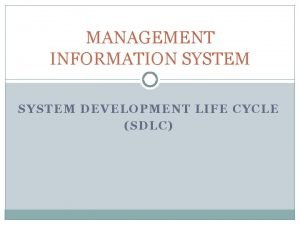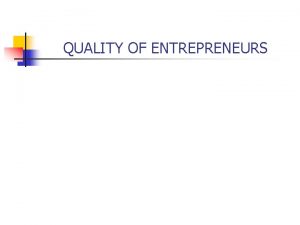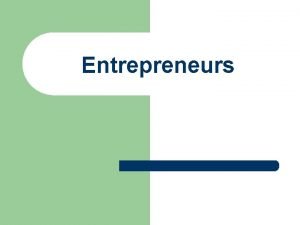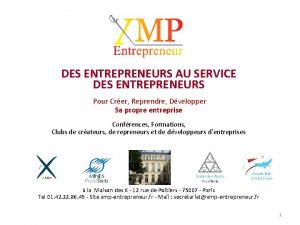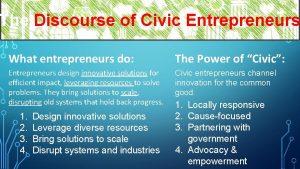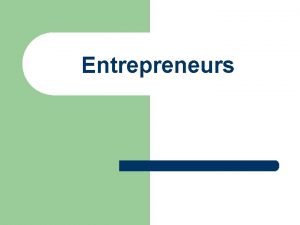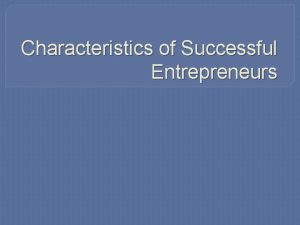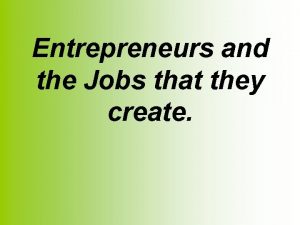Entrepreneurs Challenging The Unknown Zelimir William Todorovic Ph






























- Slides: 30

Entrepreneurs Challenging The Unknown Zelimir William Todorovic Ph. D. Doermer School of Business and management Studies Indiana University – Purdue University, Fort Wayne

Entrepreneur Is it all a Myth Entrepreneurship - The Introduction 2

Etrepreneurship in the Past • “ If you are a small businessman, you may be as extinct as the village blacksmith” • “Small business is as dead as the dodo” Entrepreneurship - The Introduction 3

Entrepreneurship Today • • 70% of economic activity Between 60% and 80% of new jobs Driven by passion and purpose U. S. standard of living (4 times better than former USSR) ascribed to entrepreneurship Entrepreneurship - The Introduction 4

Entrepreneurship - The Introduction 5

Entrepreneurship - The Introduction 6

The Evolution of Entrepreneurship • Entrepreneur is derived from the French entreprendre, meaning “to undertake”. • No single definition of entrepreneur : 1. 2. Small Business Leadership Style

Who Are Entrepreneurs? Entrepreneurs, driven by an intense commitment and determined perseverance, work very hard. They are optimists who see the cup as half full rather than half empty. They strive for integrity. They burn with the competitive desire to excel.

Common Characteristics Associated with Entrepreneurs • Commitment, Determination, and Perseverance • Drive to Achieve • Opportunity Orientation • Initiative and Responsibility • Persistent Problem Solving • Seeking Feedback • Internal Locus of Control • • • Tolerance for Ambiguity Calculated Risk Taking Integrity and Reliability Tolerance for Failure High Energy Level Creativity and Innovativeness Self-confidence and Optimism Independence Team Building

Defining The Concept Recent research has defined corporate entrepreneurship as a process whereby an individual or a group of individuals, in association with an existing organization, creates a new organization or instigates renewal or innovation within the organization.

Entrepreneurial Orientation Autonomy Innovativeness Proactiveness Competitive aggressiveness Risk-Taking

Entrepreneurial Orientation Dimension Definition Autonomy Innovativeness Proactiveness Independent action by an individual or team aimed at bringing forth a business concept or vision and carrying it through to completion. A willingness to introduce novelty through experimentation and creative processes aimed at developing new products and services as well as new processes. A forward-looking perspective characteristic of a marketplace leader that has the foresight to seize opportunities in anticipation of future demand. Source: J. G. Covin and D. P. Sleving, “A conceptual Model of Entrepreneurship As Firm Behavior, ” Entrepreneurship Theory & Practice, Fall 1991, pp. 7 -25; G. T. Lumpkin and G. G. Dess, “Clarifying the Entrepreneurial Orientation Construct and Linking It to Performance, ” Academy of Management Review 21, no. 1 (1996), pp. 135 -72; D. Miller, “The Correlates of Entrepreneurship in Three Types of Firms, ” Management Science 29 (1983), pp. 770 -91. Adapted from Exhibit 12. 3 Dimensions of Entrepreneurial Orientation

Entrepreneurial Orientation Dimension Definition Competitive An intense effort to outperform industry rivals. It is aggressiveness characterized by a combative posture or an aggressive response aimed at improving position or overcoming a threat in a competitive marketplace. Risk taking Making decisions and taking action without certain knowledge of probable outcomes; some undertakings may also involve making substantial resource commitments in the process of venturing forward. Source: J. G. Covin and D. P. Sleving, “A conceptual Model of Entrepreneurship As Firm Behavior, ” Entrepreneurship Theory & Practice, Fall 1991, pp. 7 -25; G. T. Lumpkin and G. G. Dess, “Clarifying the Entrepreneurial Orientation Construct and Linking It to Performance, ” Academy of Management Review 21, no. 1 (1996), pp. 135 -72; D. Miller, “The Correlates of Entrepreneurship in Three Types of Firms, ” Management Science 29 (1983), pp. 770 -91. Adapted from Exhibit 12. 3 Dimensions of Entrepreneurial Orientation

Entrepreneurial Orientation Risk Taking Innovation Proactiveness

Continuum of Radical and Incremental Innovations Exhibit 12. 1 Continuum of Radical and Incremental Innovations

Innovation Challenges • Seeds versus Weeds • Experience versus initiative • Internal versus external staffing • Building capabilities versus collaborating • Incremental versus preemptive launch

Managing Innovation • Firms need to regulate the pace of innovation – Incremental innovation (six months to two years) – Radical innovation (Typically 10 years or more) • Innovation often requires collaborating with others who possess complementary knowledge and skills • Innovation requires the knowledge of the market

Market Knowledge needed for Innovation • Consumers • Competitors

Market Knowledge needed for Innovation • Consumers – Decide on your target consumers – Understand your target consumers – Common mistakes: • Knowing the size of the market does not mean you know your target consumers • Selecting a specific target segment does not mean you are going to reject consumers from other segments. On the other hand, providing services and products to consumers from different segments does not mean you are targeting on everybody.

Competitors • The size of industry • The number of competitors/substitutes • The competitive advantage for each competitors • What is your niche market?

The Age of Gazelles • A “gazelle” is a business establishment with at least 20% sales growth every year (for five years), starting with a base of at least $100, 000.

Gazelles - Innovation • Gazelles are leaders in innovation. • Gazelles produce twice as many product innovations per employee as do larger firms.

Entrepreneurial Assessment Approach Type of Venture Type of Entrepreneur Qualitative, Quantitative, Strategic, and Ethical Type of Environment ASSESSMENTS Do the Results of the Assessments Make Sense Given: Stage of Entrepreneurial Career Prior Experience and Education Early Career Mid Career Late Career

3 M’s Innovation Rules • Don’t kill a project • Tolerate failure • Keep divisions small • Motivate the champions • Stay close to the customer • Share the wealth

“Corporate Entrepreneurship Assessment Instrument (measured key entrepreneurial climate factors) • • • Management Support Autonomy/Work Discretion Rewards/Reinforcement Time Availability Organizational Boundary

The Entrepreneurial Perspective Although certainly not an exact science, this perspective provides an interesting look at the entrepreneurial potential within every individual.

Figure 2 Interrelationship of Entrepreneurs and Managers - Modified E N T R E P R E N E U R Approximate Entrepreneur’s capability Approximate AGT need A Managerial Skills Required Entrepreneurial Skills Required C B Entrepreneurial and Managerial Skills Required D Open Systems Model Rational Goal Model Internal Process Model Human Relations Model M A N A G E R

Business Incubators • Business incubators are designed to “hatch” new businesses • Incubators provide some a number of resources to a new venture

Growth E M P H A S I S Cost Minimization Coaching/ Business Support Business Networking Infrastructure Fortifying Time (Months)

Growth Incubator as a Growth Tool Coaching/Busines s Support Dom ina nt Time Pro gre (Months) ssio n Infrastructure Fortifying Cost Minimization Incubator as a Subsidy Tool
 Unknown entrepreneurs
Unknown entrepreneurs 8 stages of sdlc
8 stages of sdlc Challenging resistance to change
Challenging resistance to change Time intensity model challenging behaviour
Time intensity model challenging behaviour Dealing with challenging patients
Dealing with challenging patients Challenging behaviour scenarios
Challenging behaviour scenarios Children challenging industry
Children challenging industry What i found challenging
What i found challenging The most creative and challenging phase of sdlc is
The most creative and challenging phase of sdlc is Examples of challenge
Examples of challenge Periodic table sentences
Periodic table sentences Ptsd a-b-c worksheets examples
Ptsd a-b-c worksheets examples Exciting, boring, dangerous, safe, interesting, challenging
Exciting, boring, dangerous, safe, interesting, challenging ưu thế lai là gì
ưu thế lai là gì Thẻ vin
Thẻ vin Thể thơ truyền thống
Thể thơ truyền thống Cái miệng nó xinh thế
Cái miệng nó xinh thế Các châu lục và đại dương trên thế giới
Các châu lục và đại dương trên thế giới Bổ thể
Bổ thể Từ ngữ thể hiện lòng nhân hậu
Từ ngữ thể hiện lòng nhân hậu Diễn thế sinh thái là
Diễn thế sinh thái là Tư thế ngồi viết
Tư thế ngồi viết Frameset trong html5
Frameset trong html5 Thế nào là giọng cùng tên
Thế nào là giọng cùng tên Phép trừ bù
Phép trừ bù Chúa yêu trần thế alleluia
Chúa yêu trần thế alleluia Hổ sinh sản vào mùa nào
Hổ sinh sản vào mùa nào đại từ thay thế
đại từ thay thế Vẽ hình chiếu vuông góc của vật thể sau
Vẽ hình chiếu vuông góc của vật thể sau Công thức tiính động năng
Công thức tiính động năng Tỉ lệ cơ thể trẻ em
Tỉ lệ cơ thể trẻ em








